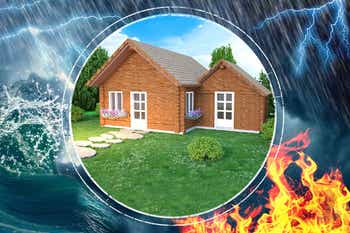The homeowners insurance industry has evolved to meet the needs of modern families, but did you know, at one time, fire insurance was all that was available to Americans?
Established in 1752 by Benjamin Franklin and his fellow firefighters, the Philadelphia Contributionship for the Insuring of Houses from Loss by Fire was the first insurance company in America1. Houses at the time were mainly constructed of wood and often built in close proximity to one another, making it hazardous and costly if a structure burst into flames and spread to neighboring properties. The Contributionship helped protect against those losses.
Buildings were inspected to determine if they were safe or not and then, at a monthly meeting, the board of directors would vote on whether or not a property should be insured. Houses built not conforming to legal specifications were denied insurance.
While fire is still one of the most common homeowners insurance claims, today’s homeowner insurance policies now help protect against a number of losses, including water leaks, windstorms, hail damage, theft and other unforeseen circumstances.
Here are the most common types of homeowners insurance claims and some tips to help protect your property from these losses.
Water
Claims due to water-related damages account for nearly half of homeowners claims, according to Mercury Insurance. Water damage is usually caused by bursting or leaking pipes, plumbing issues, malfunctioning household appliances such as refrigerators, hot water tanks, dishwashers, washing machines and HVAC issues.
Homeowners can take the following steps to protect against water damage.
Inside:
- If the temperature dips below freezing during cold winter months, be sure to let faucets served by pipes that run against exterior walls drip cold water to help prevent pipes from freezing and potentially bursting. Leaving cabinet doors open to allow warmer air to circulate around plumbing also helps.
- Inspect pipes for cracks and leaks. If you find any, have them repaired or replaced immediately.
- Check appliance hoses at least once a year and replace any that are cracked or have leaks.
- Review the manuals for your appliances for maintenance tips to keep them in good working order.
- Make sure showers, tubs and sinks are properly sealed and caulked.
- Know the location of your main water shutoff valve so you can turn off your water supply in the event of a burst pipe or damaged hose.
- When taking a vacation, turn off the main water supply to help keep the pressure from building up. Many homeowners encounter a water leak when returning home, and this simple step can keep one from happening.
Outside:
- Keep rain gutters and downspouts free of debris. Install gutter guards to prevent debris from accumulating and position downspouts to direct water away from the house.
- Ensure windows are properly sealed and caulked.
- Inspect the roof for damaged, missing or old shingles and replace them. If potential damage isn’t easily visible from the ground or a window, it’s best to hire a professional for the inspection.
Note: homeowners insurance doesn’t typically cover damage caused by rising water related to weather or run-off from overflowing bodies of water. Flooding is the nation’s most common natural disaster, so it’s important to make sure your property is properly protected if you live in an area that can be impacted by these types of events. Visit www.floodsmart.gov to learn more about how to get flood insurance or speak to your insurance agent.
Hail
Hail forms when thunderstorms carry water droplets into the atmosphere above freezing levels. Once frozen, the droplets plummet to the ground, which causes billions of dollars in damages to homes’ roofs and windows, vehicles and crops. Hail cost the insurance industry $8.4 billion and was responsible for 20 percent of claims in 2016, according to the 2017 Home Trends Report.
Protect your property from these icy projectiles.
- Invest in hail-resistant roofing materials.
- Protect windows by closing storm shutters when severe thunderstorm warnings are issued.
- Move patio and lawn furniture and potted plants indoors before a storm.
Read more about minimizing damage from hail storms.
Fire
The U.S. wildfire season was very active in 2017, leading to one of the year’s billion-dollar disaster events. Additionally, the National Fire Protection Association reports nearly half a million structure fires occurred in 2016, resulting in $7.5 billion in property damage.
Homeowners can take the following precautions to help protect against fire damage.
Inside:
- Install smoke detectors in each room on each floor and check them regularly to ensure they’re in working order. Modern alarms can be synced to smartphone apps, which will alert you if smoke is detected even if you aren’t home, and several have implemented voice alerts instead of loud beeps.
- Don’t overload wall outlets or use items with frayed electrical cords.
- Keep flammable items, like curtains and furniture away from portable heaters and turn heaters off before going to sleep.
- Don’t leave lit candles unattended and keep them out of reach of children and pets.
- Keep at least one fire extinguisher in your home. Make sure everyone knows how to properly use it and have it inspected once a year.
- Never leave a lit stove unattended and keep flammable materials away from the burners.
- Establish an escape plan in the event of a fire and practice it with your family twice a year.
Outside:
- Regularly mow your lawn and clear away clippings, dry twigs and branches from buildings. Be sure to clear your roof and gutters of leaves and other debris that can become a fire starter.
- Trim tree branches and prune bushes.
- Keep garden hoses attached to faucets during warmer months to aid fire personnel, if necessary.
- If a wildfire starts, track smoke and its impact on your visibility to determine if you should evacuate prior to an official evacuation notice being put in order. Monitor if the fire and smoke change direction to determine your safest evacuation route.
Landscaping can play an important role in protecting your home from fires. Consult your local garden center to learn more about fire-resistant plants and shrubs – it may save you money in the event of a loss.
Mercury has many other articles related to wildfire preparation and protection.
Theft
The Insurance Information Institute reports theft affects one in 235 insured homes annually. Theft happens more frequently during times when people are less likely to be at home, like during summer months when many go on vacation, or during school or work hours.
Here are a few things you can do to reduce your theft risk.
- Use social media wisely – disable geo-tagging features on your apps, resist the temptation to check in at events or restaurants and don’t advertise vacation plans. While on vacation, refrain from posting photos until you return home.
- Use light timers to give the appearance you’re home even if you aren’t.
- Change up your daily routine to make it difficult for potential thieves to predict when you’re home.
- Keep windows and doors locked, and don’t leave spare keys under door mats, on door frames or in other easy-to-find locations.
- Consider installing a security system. Some can be monitored from a smartphone while you’re out of the house.
- Temporarily stop mail and newspaper service if you plan to be out of town.
- Notify a trusted neighbor when you’ll be away so they can keep an eye on your house. Another option is to ask a friend or family member to housesit while you’re away.


